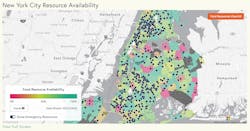Deployments of Social Service Referral Platforms Pay Off During COVID Emergency
Health systems that have launched efforts to create closed-loop referral systems to community-based organizations (CBOs) have found the work paying off during the COVID pandemic. In recent interviews, two New York-based executives described how they ramped up referral efforts to meet COVID patient needs.
To better address social determinants of health, nonprofit Northwell Health, New York State's largest healthcare provider with 23 hospitals, launched a pilot in October 2019 involving its Health and Recovery Plan (HARP) patient population on Long Island. “They are really the most challenging population from a care management standpoint,” explained Stephanie Kubow, Northwell’s assistant vice president of community health. “They have a number of chronic conditions as well as co-morbidities with mental health and/or substance use disorders and can be HIV-positive.”
Northwell rolled out the pilot using a platform called NowPow, which supports closing the loop on care with tracked and coordinated referrals, which is important for people with more complex needs. “We have seven tracked referral partners offering home and community-based services specific to our HARP patient population’s needs,” Kubow said. “That pilot has been going very well; then COVID hit, and a lot of these social determinant of health needs started skyrocketing,” she added. “We wanted to take care of individuals who tested positive for COVID so that to the extent possible we could keep them socially isolated, while still providing them with food and other resources.”
Northwell also wants to address the needs of individuals who may be at high risk but have not tested positive. “A lot of people were losing their jobs, food insecurity was ramping up, and a lot of mental health issues started coming out,” Kubow explained. So Northwell decided to start a wider roll-out of NowPow’s NowRx component, which doesn’t include tracking and coordinated referrals, but does provide resource coordinators, social workers and individuals a personalized list of referrals called a “HealtheRx.” (NowPow gives the CBOs access to the referral platform through a free tool called CommRx.)
Although tracked referrals might be preferable in the long run for some high-risk populations, Northwell decided that because this was an emergent need and many of the community-based groups are stressed to the limits with many working remotely, this was not the time to have conversations about having tracked referrals, particularly because there is contracting involved.
In that wider roll-out, Northwell began offering NowPow through its general Health Home and House Calls, a program that targets the very frail elderly, because they were seeing that food insecurity was becoming one of the largest issues with that patient population. “We also rolled it out to our Infectious Disease Health Home that treats the HIV/AIDS population,” Kubow said. “If they haven’t contracted COVID, we want to make sure we try to address their social needs to minimize their risk. We have also rolled this out to our transitional care and our complex care management team in the Health Home. We are going to roll it out in a few weeks to social workers at Long Island Jewish Medical Center, so that we can address the needs of inpatient populations as they are nearing discharge. With COVID patients, there were a lot of wrap-around social needs they identified, and having a platform for providing referrals streamlines that process and makes it easier for a patient who is being overwhelmed by medical issues.”
NowPow, the company behind the platform, worked to do validations of CBO operations during the COVID crisis — whether they have changed operations, are working remotely, halted operations or if they have added services to help address the crisis, particularly around food insecurity. “That has been very helpful in allowing our care managers and social workers to target appropriate organizations to refer to,” Kubow said. “Things can change on an almost hour by hour basis.”
NowPow also recently launched the first in a series of interactive maps to show how the COVID-19 outbreak is affecting community resource availability in the United States. For instance, the first maps focus on food resources in three of the nation’s hardest-hit areas: New York City, Long Island, and Chicago. The company notes that its network continues to expand. In New York alone, NowPow has 37,000 care professional users across nearly 1,000 organizations. Those users have made more than 100,000 referrals in 2020, and NowPow’s New York resource directory supports referrals to 27,000 CBO services.
Looking at the bigger picture, Northwell is also working with Dallas-based Pieces Technologies on a complementary technology that uses machine learning algorithms to create a social vulnerability index (SVI) both for individual patients and communities. “That is something that I am overseeing as well,” Kubow said. “Eventually we are trying to get two worlds to merge together, identifying need with the individual SVI and using the NowPow referral platform to address the issues identified. We have been working with Pieces to develop the initial algorithm for the vulnerability index. Now we are looking to see what opportunities there are for utilizing the SVI given where the health system is in terms of trying to get operations ramped up to the ‘new normal’ operations. We are using this as an opportunity to think through our next steps with a COVID lens.”
The vulnerability index has both an individual patient index and a community level index. “In a patient visit, we want the provider to see not only what a patient’s health issues are, but also what things in their community come up as potential social determinant issues,” Kubow said. They can talk about those issues and perhaps refer the patient to services using the NowPow platform. “We are working to build out that tracked referral network so that we know that the individual is actually getting connected to those services. Eventually our vision is to have NowPow embedded in the EHR and have the vulnerability index embedded as well.”
Looking ahead, Kubow said that as more care moves to telehealth, Northwell’s community health programs are going to have to adapt to interact in that environment. “Some people in underserved communities don’t have the resources to do telemedicine at home,” she said. “How are we going to work around those issues? We have to make sure that by moving to more technology we are not negatively impacting those who can least afford it.”
Engaging Patients in New Ways
Another New York City health system that had recently begun using NowPow to engage community-based organizations also shifted into high gear during the COVID crisis.
Israel Rocha serves as CEO of NYC Health + Hospitals/Elmhurst, a 545-bed Level 1 trauma and academic medical center that was at the epicenter of the COVID crisis in New York. He also serves as CEO of OneCity Health, a subsidiary of NYC Health + Hospitals focused on the implementation of a $1.2 billion transformative health program under the state’s Delivery System Reform Incentive Payment (DSRIP) program.
“We had been working to connect patients to services like cooking classes, nutritional counseling, and housing assistance programs,” Rocha said. “Our social workers would connect them and track them through the NowPow platform once we received patient consent. During COVID, it allowed us to continue to stay in touch and get patients connected to services that were so essential. With COVID, not only did patients have clinical concerns, but they also had factors of life — some people didn’t have constant employment, so food, housing and social services issues arose. It was important for us to have a means to connect people to the nonprofits we are working with such as the Korean Community Services Organization, as well as others throughout Queens. This is a technology that allowed us to be able to bridge the gaps in physical contact and share information with each other.”
Rocha said that through the Community Care Division, they were able to set up a hospitals-to-hotels program that would give patients a place to go if they need to be quarantined or had a concern about going back to their families or needed a little more time to recover. “We worked with patients throughout their hotel stay using NowPow to connect them to any social services they needed.”
Like Northwell’s Kubow, Rocha has his eye on developing a strategy for the new normal. “We can all agree that going forward we will have a new normal way of operating,” he said. “We have to find innovative ways to better match patients to care and engage patients in new ways. We have to make sure we are able to connect patients to organizations that are going to help reduce their social risk factors. We are looking at every opportunity to make it easier for patients to get the services they need.”


